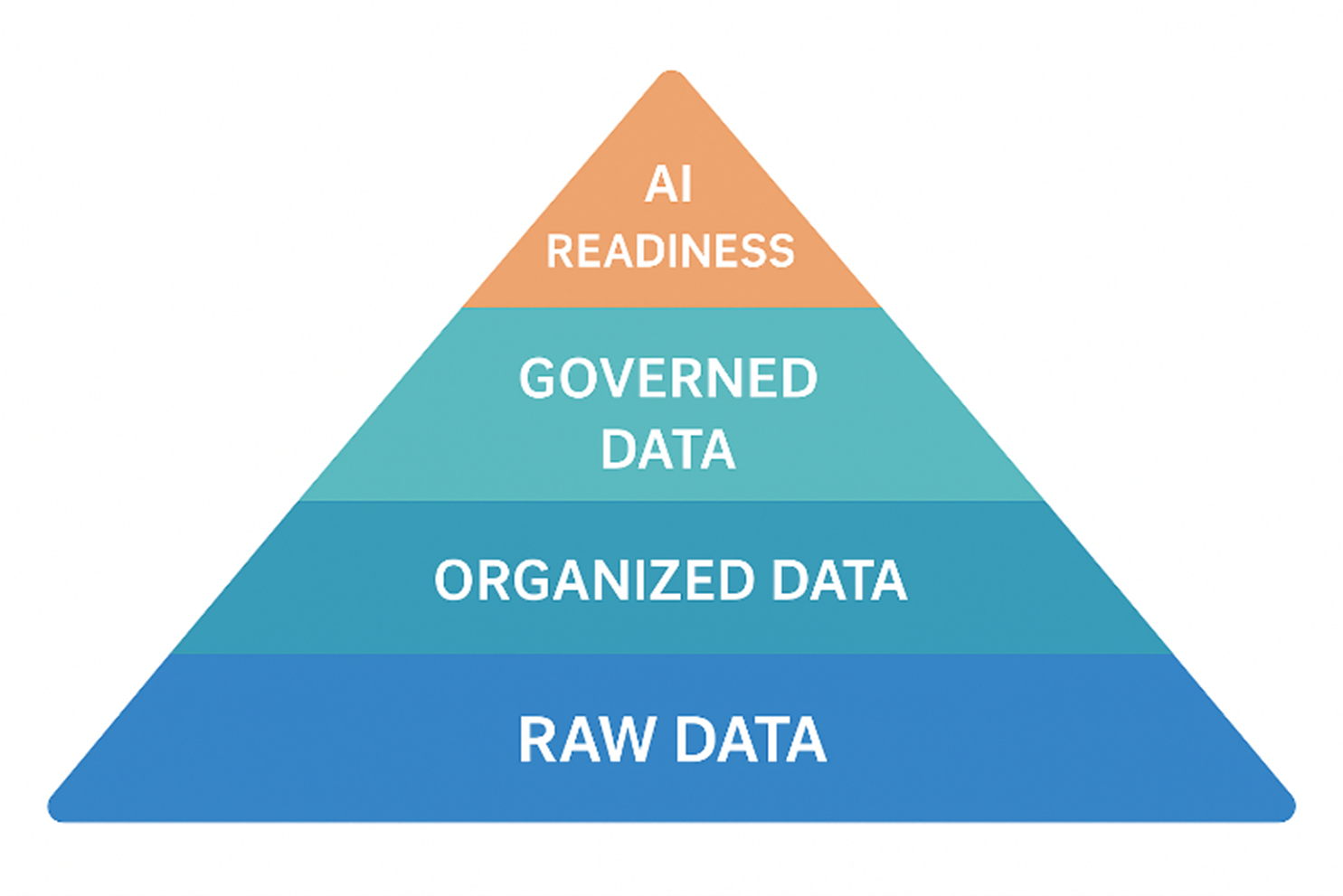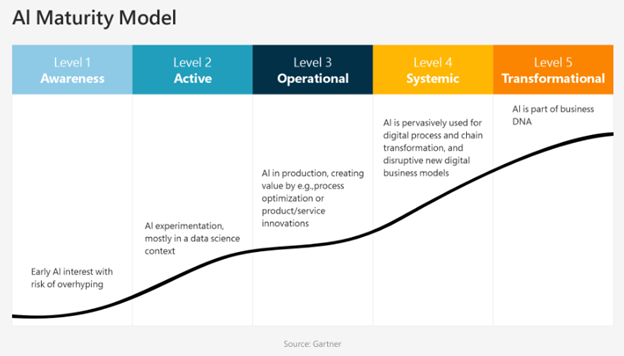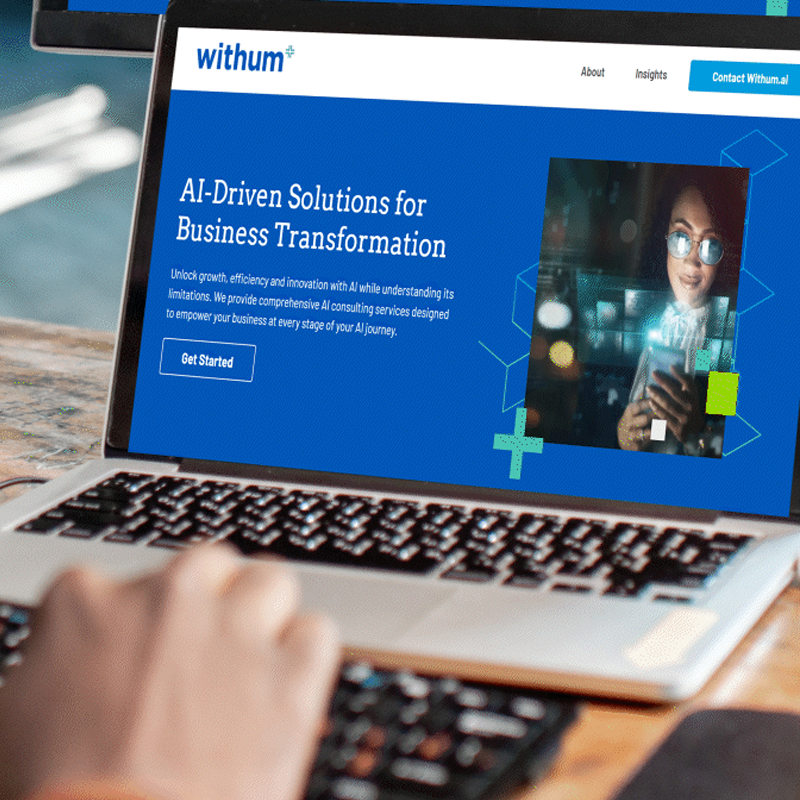The buzz around Artificial Intelligence (AI) is everywhere. It promises unprecedented efficiency, enhanced customer experiences, deeper insights and potentially new revenue streams. However, navigating the path to a successful AI business strategy can feel overwhelming. We’ve seen firsthand that while the potential is immense, the reality often falls short of expectations.
Most online content about how to implement AI in business is either overly technical, pushing specific products without a strategic foundation, or fails to connect the technology to a clear business case. The result? A staggering number of AI projects fail – over 80%, twice the failure rate of typical corporate IT projects. A lot of money is being wasted, often without clear lessons learned.
This doesn’t have to be your story. Drawing on our experience, we believe the key lies in building a practical path grounded in AI strategy, data and quick wins.
Why AI Rollouts Often Fail in Business
We’ve identified common pitfalls that lead to AI project failures:
- Lack of a Clear Business Case and Strategy: Many organizations jump into AI without defining their purpose, the decisions they want to make or the processes they want to automate or improve. There’s no documented path.
- Shiny Object Syndrome: Viewing AI as a magic bullet to solve all problems or instantly boost productivity rather than a long-term journey.
- Poor Data Quality and Governance: AI is only as good as the data it uses. Raw data, often scattered across systems, must be organized, consolidated and cleaned. Lack of proper governance around security, compliance and discoverability can create significant issues and erode trust when initial projects fail.
- Lack of Combined Mindset and Skillset: Success requires champions within the organization who understand both the business needs and the technical possibilities. Translating the benefits of AI across different departments (finance, HR, etc.) is crucial. Organizations may also lack the necessary technical expertise, like machine learning experts.
- Skipping Foundational Steps and Rushing: Many companies rush into complex AI applications without establishing the necessary data foundations or securing stakeholder alignment. This is like shooting straight to Level 5 of AI maturity without building the intermediate levels.
- Failure to Build Momentum: Without initial wins, it’s difficult to gain buy-in and support across the organization.
Building a Practical AI Implementation Strategy
Instead of starting with technology, start with AI fundamentals. We advocate for a structured AI implementation strategy:
- Understand Your Purpose and Reality Check: Before anything else, define what you want to achieve with AI. What decisions or processes are you targeting? Also, be realistic about the high failure rate and the need for iterative development. Treat it like a software development lifecycle–expect some failures, get feedback, iterate and improve.

- Establish Your Data Foundation: Data is the biggest piece of the AI readiness pyramid.
- Identify the raw data relevant to your chosen purpose.
- Organize and consolidate this data, focusing only on what’s relevant.
- Clean the data to remove irrelevant information.
- Implement simple governance focused on outcomes like cleaner data, better access control and faster insights. While people dislike discussing governance, it’s essential for security and compliance, but it should be a bridge connecting different parts of the organization, not a barrier. Aim for minimal rules initially, which are automated behind the scenes.
- Find Opportunities and Align Teams: Talk to your employees across different departments. Ask them about their daily tasks, their biggest pain points and how they currently perform processes. People know where the opportunities are for improvement.
- Stakeholder Alignment Is Crucial: You need champions who can communicate the value of AI (cost savings, time savings, reducing friction) in language relevant to each department. Think of establishing an “AI committee” for recurring alignment meetings to keep your organization on track with its AI strategy.
Navigating the AI Maturity Model
Achieving true transformation with AI is a journey and can be viewed through an AI maturity model with five levels:

Level 1 – Awareness: Conversations about AI are happening, but not strategically, and no pilot projects or experiments are taking place.
Level 2 – Active: AI is appearing in proof of concept, possibly pilot projects, with meetings focusing on knowledge sharing and the beginnings of standardization.
Level 3 – Operational: At least one AI project has moved to production. Best practices, experts, and technology are accessible to the enterprise, and AI has executive sponsorship and a dedicated budget. This is considered a worthwhile goal for competing effectively.
Level 4 – Systemic: Every new digital project at least considers using AI, and new products and services have embedded AI. Employees understand the technology, and AI applications interact productively within and across the business ecosystem.
Level 5 – Transformational: AI is now part of your business’s DNA.
Many organizations are currently at Level 1, just trying to figure out what to do, while their competitors may be at Level 2 or Level 3. The tendency to rush straight to Level 5, skipping foundational steps, is a common pitfall. Instead, think of AI in blocks and phases.
Build Momentum with Quick AI Wins
Once you have a foundation, aim for early successes. These quick wins demonstrate value and generate buy-in. Examples from our experience and the field include:
- Enhancing User Productivity: Use generative AI tools like Copilot for tasks such as drafting emails with appropriate tone and clarity, getting summaries of meetings (especially useful for catching up if late or identifying action items), improving written content in documents and presentations, and converting document types. The deep integration of tools like Copilot into existing workflows (e.g., Microsoft 365) is a significant advantage here.
- Personal Automation: Automate repetitive individual tasks, such as compiling information from various sources (emails, meetings, documents) to complete timesheets quickly.
- Simple Data Analysis: Use AI to generate formulas or quickly analyze data sets for specific needs, like calculating average growth rates.
- Improving Internal Communications/Presentations: Using generative AI to tailor presentations for specific internal or external audiences by providing context about the audience and the goal. We’ve seen how providing the right context to the AI can help restructure content to better resonate with busy internal partners, leading to increased interest.
- Targeted Sales Guidance: AI can analyze demographic and location data to guide sales teams on which specific leads are most likely to become customers, significantly increasing confidence, clarity, and morale among the sales force. This can start simply and evolve to include more complex routing and traffic optimization.
Think of AI as a Journey: Achieving true transformation with AI takes time and moves through different levels of maturity (Awareness, Active, Operational, Systemic, Transformational). Aiming for Level 3 (Operational), where at least one project is in production with dedicated resources and executive sponsorship, is a valuable initial goal for many organizations. Avoid the temptation to skip levels and rush directly to complex, enterprise-wide applications.
Check out this demo of two foundational uses of generative AI that can result in Copilot quick wins and end-user value!
Your Path to Building an AI Business Strategy
AI is not a single product or a one-time implementation; it’s an endless journey of continuous improvement and discovery. There’s no universal recipe for how to implement AI in business, but a practical AI implementation strategy focusing on data, purpose, quick wins and alignment is key. With the right mindset and strategy, AI can evolve from a buzzword into a core driver of innovation and competitive business advantage. Start small, set reasonable expectations, stay focused on practical AI fundamentals and build lasting momentum and success.
AI Solutions for Your Business
Explore withum.ai, your go-to resource for AI strategy, implementation and responsible adoption. Find practical insights and expert guidance to help your business effectively navigate the AI landscape.
Contact Us
Wondering how to incorporate AI into your business strategy? Contact our Digital Workplace Solutions Team today to explore how AI can support your business strategy and growth.







